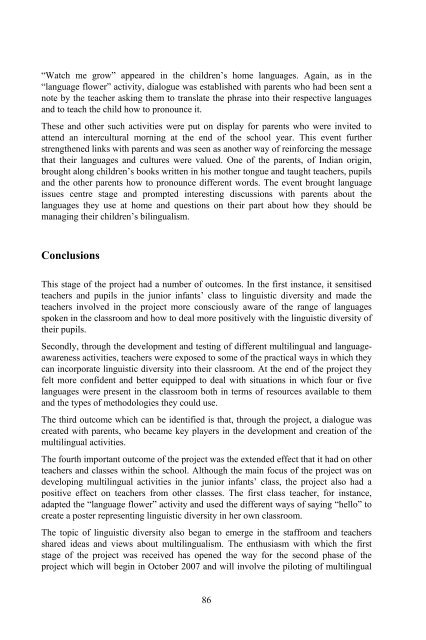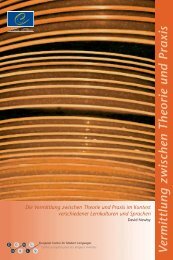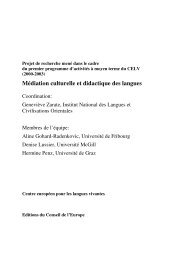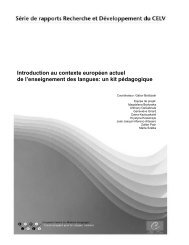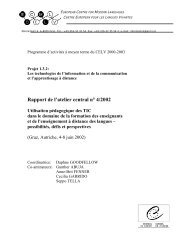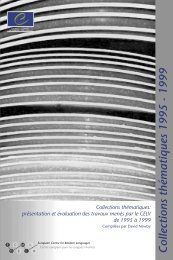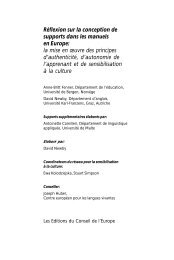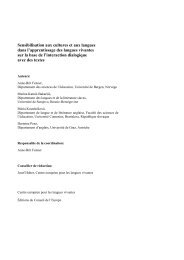cohesion - European Centre for Modern Languages
cohesion - European Centre for Modern Languages
cohesion - European Centre for Modern Languages
You also want an ePaper? Increase the reach of your titles
YUMPU automatically turns print PDFs into web optimized ePapers that Google loves.
“Watch me grow” appeared in the children’s home languages. Again, as in the<br />
“language flower” activity, dialogue was established with parents who had been sent a<br />
note by the teacher asking them to translate the phrase into their respective languages<br />
and to teach the child how to pronounce it.<br />
These and other such activities were put on display <strong>for</strong> parents who were invited to<br />
attend an intercultural morning at the end of the school year. This event further<br />
strengthened links with parents and was seen as another way of rein<strong>for</strong>cing the message<br />
that their languages and cultures were valued. One of the parents, of Indian origin,<br />
brought along children’s books written in his mother tongue and taught teachers, pupils<br />
and the other parents how to pronounce different words. The event brought language<br />
issues centre stage and prompted interesting discussions with parents about the<br />
languages they use at home and questions on their part about how they should be<br />
managing their children’s bilingualism.<br />
Conclusions<br />
This stage of the project had a number of outcomes. In the first instance, it sensitised<br />
teachers and pupils in the junior infants’ class to linguistic diversity and made the<br />
teachers involved in the project more consciously aware of the range of languages<br />
spoken in the classroom and how to deal more positively with the linguistic diversity of<br />
their pupils.<br />
Secondly, through the development and testing of different multilingual and languageawareness<br />
activities, teachers were exposed to some of the practical ways in which they<br />
can incorporate linguistic diversity into their classroom. At the end of the project they<br />
felt more confident and better equipped to deal with situations in which four or five<br />
languages were present in the classroom both in terms of resources available to them<br />
and the types of methodologies they could use.<br />
The third outcome which can be identified is that, through the project, a dialogue was<br />
created with parents, who became key players in the development and creation of the<br />
multilingual activities.<br />
The fourth important outcome of the project was the extended effect that it had on other<br />
teachers and classes within the school. Although the main focus of the project was on<br />
developing multilingual activities in the junior infants’ class, the project also had a<br />
positive effect on teachers from other classes. The first class teacher, <strong>for</strong> instance,<br />
adapted the “language flower” activity and used the different ways of saying “hello” to<br />
create a poster representing linguistic diversity in her own classroom.<br />
The topic of linguistic diversity also began to emerge in the staffroom and teachers<br />
shared ideas and views about multilingualism. The enthusiasm with which the first<br />
stage of the project was received has opened the way <strong>for</strong> the second phase of the<br />
project which will begin in October 2007 and will involve the piloting of multilingual<br />
86


